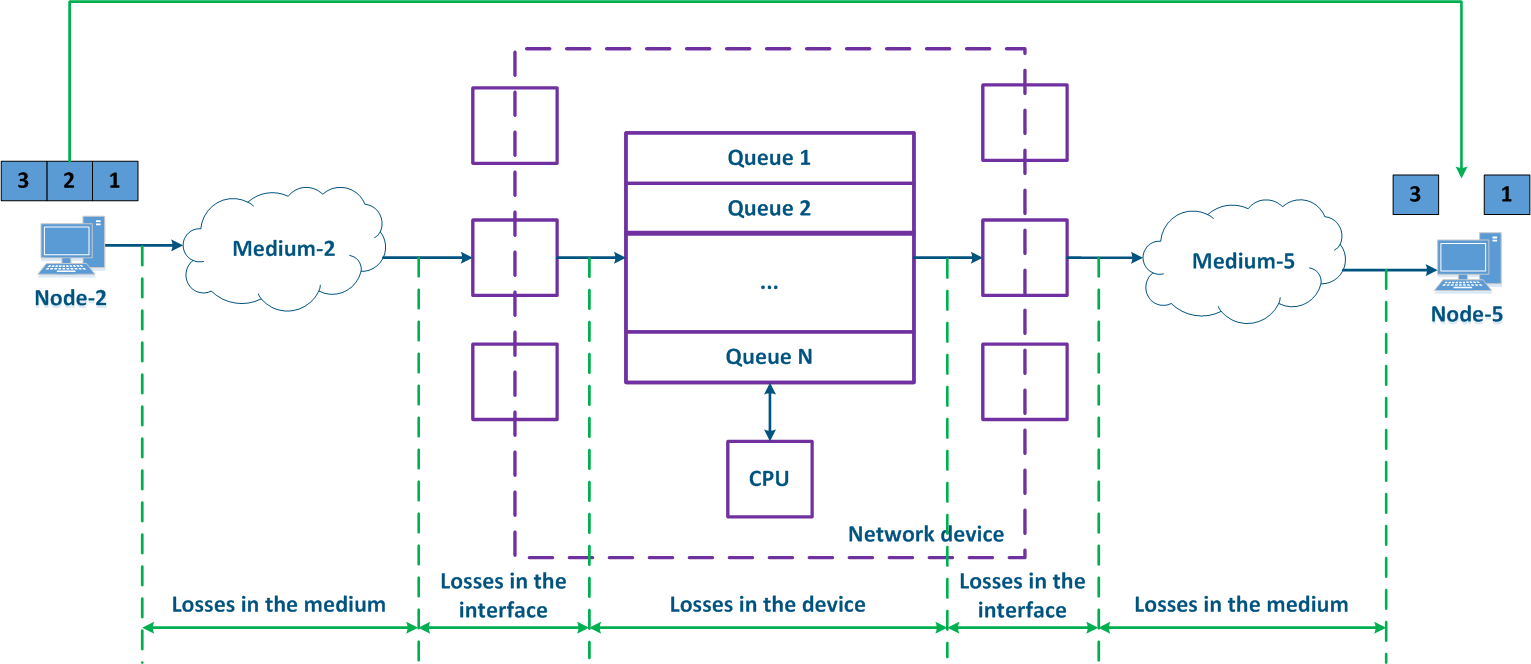...
A network device can be intermediate for several pairs of nodes and each node can transmit the data of several services (Figure 2a). Let's look at the a scheme where the "Network device" is an intermediate node for the traffic coming from the following pairs of nodes: Node-1 - Node-4, Node-2 - Node-5 and Node-3 - Node-6. The first pair transmits data for three services, the second for two and the third for one service. If there are no QoS settings, the data of all services get through the general queue in the order they are received at the "Network device" and in the same order they will be transferred from the queue to the outgoing interfaces.
With QoS configured, each of the incoming traffic flows can be classified by its type (for example) and a separate queue can be mapped to each class (Figure 2b). Each packet queue can be assigned a priority, which will be taken into account while extracting the packets from the queues, and will guarantee specific quality indicators. The traffic flow classification can be performed not only with respect to the services used, but according to other criteria also. For example, each pair of nodes can be assigned to a separate packet queue (Figure 2c).
...
Keep in mind that several intermediate network devices can be located on the data path between the source and the receiver, having independent packet queues, i.e. an effective QoS policy implementation will require the configuration of all the several network nodes.
| Anchor | ||||
|---|---|---|---|---|
|
...
During a data stream transmission, some packets may not be received, or may be received with errors. This process is called data loss , and it is defined as the ratio between the number of received packets and the number of transmit transmitted packets. In the example below (Figure 3), Node-2 transmits packets with the identifiers 1, 2 and 3, however, Node-5 receives only packets 1 and 3, i.e. the packet with the identifier 2 was lost. There are network mechanisms which allow the retransmission of the lost data. Examples of such mechanisms are the TCP and the ARQ protocols.
...
| Center |
|---|
Figure 3 - Data packet loss example |
Losses The losses affect two indicators: throughput and packet performance.
...
One of the main indicator that is practically used is the throughput, whose value depends on the losses. Throughput The throughput is defined by the capabilities of the physical 's channel capabilities and by the ability of the intermediate network devices to process the data stream. The link throughput is defined as the maximum amount of data that can be transmitted from the source to the receiver per unit of time.
...
Due to the limited amount of internal memory, better packet performance is achieved for the minimum frame size. Using minimum sized frames assumes a large amount of overhead amount since each data frame has a service header, whose size does not depend on the size of the frame itself.
...
Delay is defined as the time it takes for a packet to travel from the source to the destination. The value of the delay 's value depends on the following aspects:
- The signal's propagation duration in the medium: depends on the physical characteristics of the medium and it is nonzero
- Serialization time: the conversion of a bitstream to a signal and backward by the incoming/outgoing interfaces is not instantaneous and makes use of the hardware resources of the network device.
- Processing time: the time spent by the data packet inside the network device. This time depends on the status of the packet queue, as a data packet will be processed only after processing the packets placed earlier in this queue earlier.
The delay is often measured, as a round-trip time (RTT), i.e. the time it takes for the data packet to be transmitted from a the source to a the destination and backward. For example, this value can be seem seen in the ping command's results. The time it takes for the intermediate network devices to process the data packets forward and backward may differ, therefore, usually the round-trip time is not equal to the double of the one-way delay.
...
